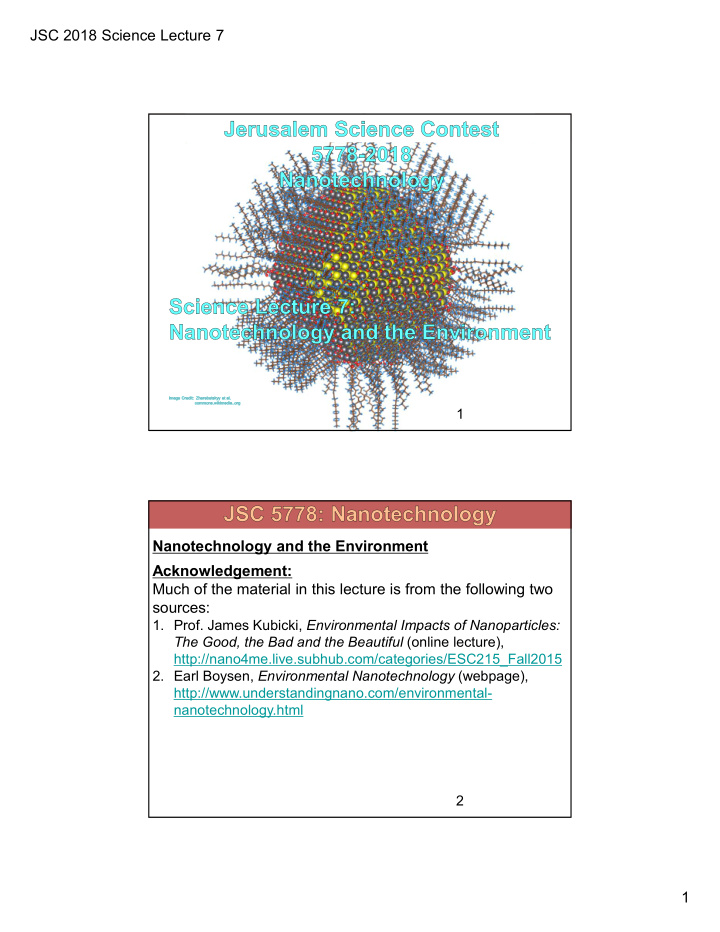



JSC 2018 Science Lecture 7 1 Nanotechnology and the Environment Acknowledgement: Much of the material in this lecture is from the following two sources: 1. Prof. James Kubicki, Environmental Impacts of Nanoparticles: The Good, the Bad and the Beautiful (online lecture), http://nano4me.live.subhub.com/categories/ESC215_Fall2015 2. Earl Boysen, Environmental Nanotechnology (webpage), http://www.understandingnano.com/environmental- nanotechnology.html 2 1
JSC 2018 Science Lecture 7 Nanotechnology and the Environment • As with many other areas, nanotechnology can potentially improve our environmental impact. • However, nanotechnology also has several negative environmental consequences (potential and real), which must be addressed • See optional reading, unit 7 • For example, nanoparticles can “escape” and pollute the environment 3 • Titanium dioxide is added to a huge swath of products in nano form including paints, paper and plastics but also lends white pigment to most toothpastes and many processed foods, 4 2
JSC 2018 Science Lecture 7 5 Some Ways Nanotechnology Can Help The Environment: 1. Cleaning up the environment (remediation) 2. Preventing pollution 3. Providing clean drinking water and water recycling 4. Creating and improving alternative energy sources (e.g. solar cells) 5. Making conventional energy generation cleaner and more efficient • (many of these applications have been covered in previous units) 6 3
JSC 2018 Science Lecture 7 1. Cleaning Up The Environment : • Detection and analysis of pollutants • Cleaning water Wastewater treatment Ground water, rivers, lakes, oceans o Removing plastics and oil spills from the ocean • Cleaning air Removing pollutants Removing greenhouse gases • Cleaning soil 7 2. Preventing Pollution : • Similar applications to previous section, except pollutants are removed before being released in the environment • E.g. Polypropylene oxide : • Produced in industry in large amounts • Used to make plastics, paint, detergents brake fluids • Many toxic and harmful by-products of production • 2010, researchers at Argonne National Laboratory, Illinois used silver nanoparticles as a catalyst to make this compound with a huge reduction in by-products 8 4
JSC 2018 Science Lecture 7 3. Providing Clean Drinking Water And Water Recycling : • Very similar to items 1 and 2. 9 Cleaning Water : • Nanoparticles of iron oxides and iron metal break down contaminants • Removes arsenic (As) in several ways • Enhances iron-reducing bacteria that also reduce and immobilize uranium • Removes chlorine from toxic solvents • Removes chromium and uranium. 10 5
JSC 2018 Science Lecture 7 4. Creating and Improving Alternative Energy Sources : • Solar cells • Wind turbines • Fuel cells (mostly for electric cars) • Other sources 5. Making conventional energy generation cleaner and more efficient 11 Solar cells : • E.g. light-sensitive nanoparticles (colloidal quantum dots) • Colloidal lead sulfide/selenide quantum dot • More sensitive to infra-red than other solar cells • Could lead to cheaper and more flexible solar cells • Also useful for better gas sensors, infrared lasers, infrared LED’s and more. 12 6
JSC 2018 Science Lecture 7 Some Ways Nanotechnology Can Help The Environment: 1. Cleaning up the environment (remediation) 2. Preventing pollution 3. Providing clean drinking water and water recycling 4. Creating and improving alternative energy sources (e.g. solar cells) 5. Making conventional energy generation cleaner and more efficient 13 Thanks for participating in the contest! Good luck on your presentations! Good luck on the final exam! 14 7
Recommend
More recommend